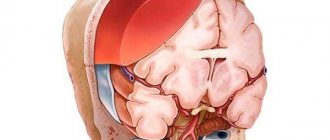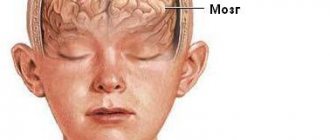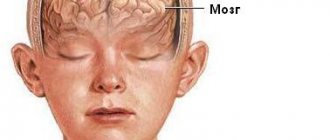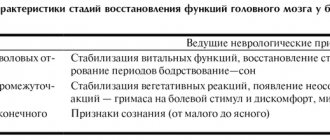What is an intracerebral hematoma
An intracerebral hematoma is a limited spherical accumulation of liquid blood in the brain tissue, as well as its clots, resulting from the rupture of a blood vessel with the subsequent formation of a hematoma in the brain tissue. In cases of trauma, the hematoma may also have inclusions of cerebral detritus (elements of brain matter and bone tissue that have entered the wound of foreign bodies).
Typically, the growth of an intracerebral hematoma is observed during the first two to three hours that have passed since the onset of hemorrhage (the time may increase if there are blood clotting disorders). Typically, hematomas of this type are often localized in the frontal and temporal lobes of the brain, much less often in the parietal lobes. At the same time, intracerebral hematomas of traumatic origin are often fixed closer to the surface of the brain, and those associated with pathology of vascular origin are in its depth.
Intracranial birth injury
A mild degree of intracranial birth injury is considered as a concussion, in which an increase in neuro-reflex excitability, tremor of the chin and limbs, spontaneous Moro reflex, increased muscle tone, and revitalization of deep reflexes predominate. The syndrome is based on transient disturbances of hemo- and liquorodynamics.
The average severity corresponds to the clinical picture of a brain contusion. The child's anxiety persists for a long time with a painful monotonous cry; hypertension of the flexor muscle groups of the upper extremities and the extensor muscle groups of the lower extremities is characteristic. There may be a stuporous state with adynamia, lethargy, polymorphic convulsions, and focal symptoms.
Severe damage is characteristic of compression of the brain. A comatose state may develop several hours or days after birth. The child reacts only to intense painful stimulation with mild motor restlessness or quiet crying. There is no sucking or swallowing. Muscle atony, reflexes are not evoked. Due to the immaturity of the nervous system, focal symptoms are difficult to identify; diffuse neurological disorders predominate.
All cases of intracranial birth injury can be divided into traumatic brain injury without intracranial hemorrhages and intracranial hemorrhages : epidural, subdural, subarachnoid, intracerebral, intraventricular, multiple intracranial hemorrhages of different locations.
Epidural hemorrhage usually occurs when the skull bones are damaged (delivery using obstetric forceps or a vacuum extractor). In this hemorrhage, blood accumulates between the bones of the skull and the dura mater (the so-called internal cephalohematoma). Unlike a subdural hematoma, there is no blood in the cerebrospinal fluid, but there may be protein-cell dissociation.
Subdural hemorrhage . Main reasons:
• sharp displacement of the skull bones (rapid labor) with damage to the vessels flowing into the superior sagittal and transverse sinuses, and the vessels of the cerebellar tentorium; • rupture of the cerebellar tentorium with increased tension in one of the leaves with hemorrhage in the region of the occipital and temporal lobes with subsequent compression of the medulla oblongata.
Clinical signs, gradual deterioration of the general condition, impaired breathing (rapid, arrhythmic), pallor, cold skin, decreased muscle tone, absence of unconditioned reflexes, in particular corneal, impaired sucking and swallowing, increasing symptoms of intracranial hypertension, Graefe's symptom, regurgitation, vomiting , focal and generalized clonic-tonic convulsions. Focal symptoms may include damage to the oculomotor nerve (usually ptosis and mydriasis) on the side of the hematoma.
Subdural hematoma of the posterior cranial fossa is especially severe, the lucid space is usually absent, and brainstem symptoms quickly increase.
Subarachnoid hemorrhage. At first, the presence of a syndrome of increased neuro-reflex excitability with general motor restlessness, tremors of the limbs, shudders, and there may be convulsions is typical. Meningeal symptoms are especially characteristic, of which the stiffness of the neck muscles is most pronounced, and tilting of the head is often noted. Cerebrospinal fluid mixed with blood or xanthochromic.
Intracerebral hemorrhage occurs mainly in premature infants. The clinical picture depends on the extent and location of the hemorrhage. With extensive hemorrhage, the child is in a comatose state from the first day. There is no reaction to irritants, the pupils are usually wide, especially on the side of the hematoma, with a sharp decrease or absence of pupillary reaction to light, floating movements of the eyeballs, muscle atonia, hypo- or areflexia. Nystagmus, convulsions with a focal component, bradycardia, and arrhythmic breathing are often associated.
Intraventricular hemorrhage. The main cause is rupture of the vessels of the choroidal plexus in premature babies during rapid labor. Clinically - deep coma, respiratory failure, cardiac activity, tonic convulsions, opisthotonus, constriction of the pupils, anisocoria, floating movements of the eyeballs, horizontal, vertical, rotatory nystagmus, tension of the large fontanelle, disturbance of vegetative-trophic functions, hyperthermia. Often fatal. A massive breakthrough into the fourth cerebral ventricle means instant death.
Reasons for the formation of intracerebral hematoma
The main reasons causing hemorrhage into the brain tissue and the formation of intracranial hematoma can be considered:
- traumatic brain injuries
- sharp increase in intravascular pressure
- rupture of cerebral aneurysm
- the presence of brain tumors that provoke arrosive bleeding
- pathology of vascular development (arteriovenous malformation)
- impaired elasticity of vascular walls (caused by atherosclerosis, diabetes, systemic vasculitis)
- the presence of diseases of the circulatory system associated with changes in blood viscosity and fluidity
- taking anticoagulants
Epi- and subdural hematomas
Sign up for a consultation by phone
Or fill out the form online
Make an appointment
Epi- and subdural hematomas occur with closed head injuries. There are epidural, subdural, combined - epi-subdural, intracerebral and intraventricular hematomas. Intracranial hematomas that form in the acute period of severe trauma to the skull and brain have their own characteristics. It is based on the fact that hemorrhages in most cases occur in the first minutes and hours after injury, i.e., during the period when brain contusion often comes to the fore, leveling the symptoms associated with the formation of an intracranial hematoma. The main symptoms of intracranial hematomas include: light gap, headache, vomiting, psychomotor agitation, changes in intracranial pressure, bradycardia, arterial hypertension, asymmetry of blood pressure, pyramidal symptoms, epileptic seizures.
The cause of epidural hematomas is most often a rupture of the branches of the middle meningeal artery. The blood flowing from the artery detaches the dura mater from the bone and forms a hematoma, which can lead to brain dislocation within the next few hours after the injury. Most epidural hematomas are located in the temporal region. In a significant percentage of cases, epidural hematomas occur as a result of blows of relatively low force. In this regard, many patients do not lose consciousness at all or note a relatively short loss of consciousness - for a few minutes, usually less than an hour. After the return of consciousness, a period of light sets in, and only after some time the patient’s condition begins to deteriorate again. Stupefaction and drowsiness appear, followed by deep depression of consciousness while maintaining reflexes and coma. Paresis of the opposite limbs may develop. Later, signs of decerebration appear. Cardiovascular disorders occur - bradycardia, increased blood pressure. If victims are not given emergency assistance, they die with increasing symptoms of compression of the brain stem and increased intracranial pressure.
Subdural hematomas are located between the dura mater and the surface of the brain. The source of their formation can be veins damaged as a result of injury, bleeding from the sinuses and blood vessels of the brain during contusion and softening. Acute subdural hematoma usually occurs with severe traumatic brain injury, accompanied by contusion and crushing of the brain. Acute subdural hematoma clinically manifests itself within the first three days. Bleeding occurs from damaged cerebral vessels in the bruise area and from torn veins. Acute subdural hematoma is one of the manifestations of severe brain injury. It develops against the background of loss of consciousness and other symptoms of massive brain damage. In this regard, the clear space, so characteristic of epidural hematomas, is often not detected. Removal of a hematoma is a necessary condition for eliminating life-threatening dislocations and compression of the brain.
Chronic subdural hematomas differ from acute and subacute ones by the presence of a restrictive capsule, which determines the characteristics of their clinical course. They are diagnosed weeks, months or (less often) years after the injury. They often occur after minor injuries that go unnoticed by the patient. This is a unique type of pathology. In the pathogenesis of chronic subdural hematomas, age-related changes, concomitant vascular pathology, alcoholism, and diabetes mellitus are of great importance. More often, chronic hematomas occur in older people (60 years and older).
Chronic subdural hematomas are manifested by headaches, mental disorders, manifested by changes in character, memory impairment, and inappropriate behavior. Chronic hematomas often reach enormous sizes. Their thickness can reach several centimeters, and their total volume exceeds 200 ml. If it is not possible to use computed tomography for diagnosis, valuable information can be obtained by ultrasound examination of the brain.
Benefits of the service
Convenient work schedule
We work until late in the evening to make it convenient for you to take care of your health after work
No queues
The patient registration system has been debugged over many years of work and works in such a way that you will be seen exactly at the chosen time
Cozy interior
It is important to us that patients feel comfortable within the walls of the clinic, and we have done everything to make you feel comfortable
Attention to the patient
At your service there are attentive staff who will answer any question and help you navigate
What are the symptoms of intracerebral hematoma formation?
Typically, the first symptoms begin to appear from the onset of hemorrhage, although their intensity directly depends on the severity of the lesion. Sometimes, from the moment the hematoma forms until characteristic symptoms are observed, a time may pass (from several hours to months), called the “light interval.” It is customary to distinguish symptoms:
1. cerebral – manifests itself:
- headache of sufficient intensity
- dizzy
- nausea, vomiting
- general weakness and drowsiness
- confused consciousness (sometimes preceded by psychomotor agitation), with a possible transition to coma (as with hemorrhage in the ventricles of the brain)
2. focal – correlated with the volume and localization of the hematoma, manifests itself:
- speech disorders
- difficulty swallowing
- hearing disorders (hard of hearing) and vision (nystagmus, drooping upper eyelid)
- behavior disorder
- loss of sensation in the limbs
- epilepsy attacks
- memory loss
- increased temperature (when blood enters the ventricles of the brain)
Multiple traumatic intracranial hematomas
Multiple traumatic intracranial hematomas include cases of simultaneous formation of two or more volumetric hemorrhages, different in their relation to the membranes and substance of the brain and/or in localization.Epidemiology
Multiple hematomas usually develop with intense head trauma, when two factors can simultaneously participate in the damaging effect: local impression and displacement of the brain (vehicle trauma, fall from a great height, etc.).
The site of application of the traumatic agent when epidural hematomas are combined with other types of blood tumors is often the lateral sections of the head; when subdural hematomas are combined with intracerebral and intraventricular hematomas, most often in the occipital region.
Multiple hematomas account for 0.74% of all craniocerebral injuries. Among the various types of hematomas, multiple ones occupy the second place in occurrence (22-25%) after subdural hematomas. The incidence of multiple hematomas increases with the age of the victims. Among all types of traumatic intracranial hematomas, multiple hematomas in children account for 9%, in young and middle-aged people - 23%, in elderly and elderly people - 45%.
Intracranial hematomas occur in various combinations, both in number, type and side of location. Multiple hematomas most often include subdural hematomas, which are combined with both epidural and subdural hematomas on the opposite side, and with intracerebral hematomas on their own and the opposite side.
Depending on the localization and relative position of volumetric intracranial hemorrhages, three groups of multiple hematomas are distinguished: “floor-by-floor”, bilateral and “in the neighborhood”. “Stage-by-floor” include unilateral hematomas located directly above one another, and bilateral include hematomas localized in different hemispheres of the cerebrum. The group of multiple hematomas “in the neighborhood” consists of unilateral hematomas located in different parts of the hemisphere. Occasionally, multiple hematomas are found, localized above and below the cerebellar tentorium. In 70-75% of cases, multiple hematomas are unilateral.
Clinic
The simultaneous development of two or more hematomas against the background of concomitant bruises, and often crushes of the brain substance, determines both the particular severity of the course of multiple hematomas and the complex interweaving in their clinical picture of individual features characteristic of one or another type of blood tumor.
Most observations of multiple hematomas are characterized by the absence of a clear space. The soporous-comatose state that occurs immediately after the injury persists for a number of hours, sometimes several days, until surgery or death. Much less often, the primary loss of consciousness after a few hours is replaced by an erased light interval with a partial restoration of consciousness to the point of stunning. In rare cases of subacute course of multiple hematomas, a three-phase change in the state of consciousness with an expanded light interval can be observed. Multiple hematomas are often accompanied by psychomotor agitation. Sometimes convulsive seizures of a general type occur. In patients available for contact, it is possible to identify a headache with a predominant localization on the side of the meningeal hematoma when combined with an intracerebral one. Repeated vomiting is often observed.
Pulse changes with multiple hematomas equally often fluctuate towards both bradycardia (42-60 beats per minute) and tachycardia (100-160 beats per minute). There is often a marked increase in blood pressure (155/90 - 230/130 mm Hg). With multiple hematomas, breathing disturbances are common with a predominance of tachypnea and rhythm changes. A significant portion of observations are characterized by early hyperthermia (38-40 C). The degree of damage to the brain stem, both primary and secondary, determines in case of multiple hematomas the severity of various changes in muscle tone and reflex sphere in their clinical picture. They manifest themselves in the form of decerebrate rigidity, hormetonia, dissociation of muscle tone and tendon reflexes along the body axis. A global decrease in muscle tone and areflexia may also be noted.
Vestibular-oculomotor disorders are common - spontaneous nystagmus, floating gaze, combined and dissociated oculomotor paresis. Many victims have a violation of the pupillary innervation in the form of bilateral mydriasis or bilateral miosis. Half of the patients with multiple hematomas have a bilateral decrease or loss of corneal reflexes. The variability of the structure of general cerebral and focal symptoms in multiple hematomas is largely determined by the parallel influence of various types of intracranial hematomas and depends on their specific combination, taking into account the size and topographic features of each of them. In a number of cases, the impact of one of the existing hematomas is leading and determines the dominance of its characteristic features in the clinical picture.
The main focal signs of multiple hematomas are craniobasal and hemispheric symptoms. Among them, the most common are unilateral mydriasis and paresis of the limbs. In most patients, a wide pupil is installed on the side of the hematoma (if it is unihemispheric) or homolateral to the hematoma that is predominant in size (if it is unihemispheric). Sometimes it is possible to trace the change from bilateral miosis to unilateral mydriasis, which can subsequently also become bilateral.
With unihemispheric localization of hematomas, hemiparesis usually develops on the contralateral side of the body. When hematomas are located in different hemispheres, the side of hemiparesis largely depends not only on the comparative size, but also on the relationship of the blood tumor to the membranes and substance of the brain. In particular, a relatively small deep intracerebral hematoma can cause much more pronounced contralateral hemiparesis than a significantly larger subdural hematoma located in the opposite hemisphere.
It should be taken into account that when hematomas are located in different hemispheres, nesting symptoms are characterized by true bilaterality, although they are often heterogeneous or, although homogeneous, are asymmetric in severity.
With multiple hematomas, severe damage to the bones of the skull is usually detected, often in the form of comminuted fractures of the vault and base.
Flow forms
Multiple hematomas in most cases are acute and cause the development of brain compression in the first hours after injury. Much less frequently (with bilateral subdural hematomas, with a combination of epidural and subdural hematomas, subdural and intracerebral hematomas), their subacute course is observed.
Acute multiple hematomas
There are three main variants of the clinical course of acute multiple hematomas.
Option without light gap. Most common. Stupor or coma that occurs immediately after injury persists or deepens without any remission, up to surgery or death. Against this background, an increase or appearance of nesting symptoms may be observed.
Option with erased light gap. It happens quite often. Impairment of consciousness after injury reaches the level of stupor, less often coma, and lasts several hours (days). Subsequently, the depth of switching off consciousness decreases to the point of stunning. After a certain period of time (from several hours to several days), the erased light interval is replaced by a repeated increase in disturbance of consciousness, often with the simultaneous appearance or deepening of nesting symptoms.
Option with an expanded light gap. Rarely seen. The clinical course is similar to the clinical variant in isolated acute epidural or subdural hematomas with an expanded light space.
Subacute multiple hematomas
Subacute multiple hematomas are in many ways similar to isolated subacute intracranial hematomas. Associated brain damage is relatively small, and there is often no damage to the skull bones. Three main variants of the clinical course of subacute multiple hematomas should be distinguished.
Classic option. It happens quite often. After a traumatic brain injury, accompanied by a relatively short-term loss of consciousness, a developed lucid interval occurs. Subsequently, consciousness gradually or suddenly switches off again. At the same time or ahead of time, focal symptoms are revealed, which, depending on the relationship of the hematoma to the membranes and substance of the brain, can be soft or rough, and depending on the unihemispheric or bihemispheric location of the hematoma - unilateral or bilateral. Among the symptoms of brain compression, congestion in the fundus may be detected.
Option without primary loss of consciousness. It is extremely rare. There is no loss of consciousness at the time of injury or the loss of consciousness remains undetermined. The further course is similar to the classic version.
Option with erased light gap. It happens quite often. The loss of consciousness after an injury reaches the level of stupor, less often coma, and lasts within several hours. Then consciousness partially clears to the point of stupor. After a certain period of time (usually several days), secondary loss of consciousness and nesting symptoms increase. A feature of the latter with a heterohemispheric location of the hematoma is its bilaterality.
Diagnostics
The severity of primary and secondary brainstem symptoms and the rapid development of compression syndrome in the majority of victims with multiple hematomas obscure the signs of focal brain damage.
Upon admission of a patient with a traumatic brain injury in stupor or coma, signs are initially identified that indirectly suggest the formation of an intracranial hematoma (duration and depth of loss of consciousness without a tendency to restore it in combination with bradycardia, arterial hypertension, decerebrate rigidity and other brainstem disorders).
The discovery of a comminuted fracture of the skull bones indicates the intensity of the injury with the possibility of the formation of multiple hematomas. Suspicion of multiple hematomas becomes justified if in the clinical picture it is possible to identify symptom complexes caused by several lesions. For example, hormetonic syndrome, automated gestures and hyperthermia are more typical for intraventricular hematomas, brachiocephalic type of hemiparesis and a contralateral fracture of the calvarial vault crossing the grooves of the middle meningeal artery - for epidural hematomas, unilateral mydriasis and fracture of the base of the skull - for subdural hematomas, capsular type of hemiparesis and absence of ipsilateral reactions to painful stimuli - for intracerebral hematomas. These signs can be reference points for an approximate judgment about the possibility of the simultaneous combination of certain types of hematomas.
In victims with an erased or expanded clear space established by history or in the hospital, the diagnosis of multiple hematomas, as well as isolated ones, is based primarily on the characteristic three-phase changes in consciousness.
Detection of bilateral focal symptoms (bilateral pyramidal disorders; combination of aphasia, hemnanopsia or unilateral mydriasis with homolateral hemiparesis, etc.), especially in the absence of signs of brain stem dislocation, should always alert to the possibility of multiple hematomas. With the diverse location of meningeal hematomas, focal symptoms, characteristic of the most massive of the hematomas, usually predominate. It should, however, be borne in mind that bilateral subdural hematomas are often characterized by soft bilateral nesting signs, making interhemispheric asymmetry unconvincing.
With unilateral localization of meningeal and intracerebral hematomas, the leading focal symptoms, as a rule, are determined by intracerebral extravasation. When there is a combination of meningeal and intraventricular hematomas, the manifestations of the stem symptom complex caused by the intraventricular hematoma often mask the signs of a meningeal blood tumor.
With multiple hematomas, severe damage to the skull bones is often detected, and comminuted fractures of the vault and base are not uncommon.
Computed tomography and magnetic resonance imaging have fundamentally changed the diagnostic situation for multiple intracranial hematomas, making their recognition quick and clear. CT and MRI semiotics of multiple hematomas is characterized by a combination of signs of each of the existing volumetric hemorrhages. Multiple bihemispheric hematomas can to some extent balance the lateral displacement of the midline structures of the brain. At the same time, the total volume of hemorrhages aggravates the infringement of the brainstem and cerebral edema. Computed tomography and magnetic resonance imaging contribute to time-appropriate recognition and control of life-threatening situations with multiple hematomas.
Treatment
The choice of treatment tactics for multiple hematomas is determined by the following factors
- separate volumes and total amount of blood poured into the subarachnoid space;
— features of location in one or both cerebral hemispheres, supra- and subtentorial, etc.;
— the presence and proportion of concomitant brain damage (foci of crush injury, depressed fractures, etc.);
— the severity of the victim’s condition according to cerebral and extracerebral indicators;
— dislocation of the brain stem according to neurological, CT and MRI data.
If, in the most common combinations of intracerebral and subdural hematoma, the volume of the first does not exceed 15-20 ml, and the volume of the second 30-40 ml and in the absence of signs of increasing compression of the brain, the level of consciousness on the Glasgow Coma Scale is not lower than 10 points, conservative management of the victim is acceptable.
In case of multiple bilateral hematomas or multiple hematomas distant from each other within the same hemisphere, only one of the hematomas, responsible for the development of brain compression, can be removed.
With a “floor-by-floor” arrangement of meningeal and intracerebral hematomas, if they cause compression of the brain and dislocation of the brainstem, conditions are created for their simultaneous removal from one access. If to eliminate compression of the brain it is necessary to evacuate two or even three intracerebral hematomas, then surgical intervention is performed on both sides or supra-, subtentorially.
However, the methods for removing hematomas themselves are different. For acute and subacute epidural and subdural hematomas, wide osteoplastic trephination is preferable, which, if necessary, can be converted into decompressive trepanation. For intracerebral hematomas, along with encephalotomy, puncture or stereotactic aspiration is used.
Prognosis and outcomes
The mortality rate for acute multiple hematomas causing compression of the brain reaches 50-70%; with subacute multiple hematomas and, accordingly, subacute development of brain compression, it is noticeably lower - 20-25%.
The life prognosis after surgical removal of multiple hematomas is largely determined by age factors: it is better in young and younger middle-aged victims, worse in the elderly and elderly.
Outcomes for multiple hematomas that do not cause a threatening compression syndrome and therefore do not require surgical intervention are more favorable.
Professor Leonid Likhterman, Honored Scientist of the Russian Federation, laureate of the State Prize of the Russian Federation. Institute of Neurosurgery named after. N.N.Burdenko RAMS.
Why is the formation of an intracerebral hematoma dangerous?
The formation of this pathology (even a small one) leads to compression of the surrounding brain tissue, which (depending on the size and location of the hematoma) can result in subsequent serious damage, even necrosis. In addition, an increase in intracranial pressure serves as a provoking factor for the development of cerebral edema. Due to displacement of brain structures, a large intracerebral hematoma often causes dislocation syndrome (a set of symptoms associated with this condition) in patients. It is also possible for a hematoma to break through into the ventricles of the brain. Since cerebral hemorrhage causes a reflex response spasm of cerebral vessels, this leads to the development of cerebral ischemia (starting from the areas closest to the hematoma). Further, pathological processes can spread to other systems of the body, affecting, first of all, the most problematic areas of the patient.
Treatment of intracerebral hematoma
The optimal treatment for this pathology, based on the individual condition of the patient, is chosen by the neurosurgeon. It can be conservative or surgical, depending on the severity and observed clinical manifestations.
Conservative therapy. It is usually used when the size of the intracerebral hematoma does not exceed 3 cm, and the pathology itself does not compress the medulla oblongata, and under the obligatory condition of the absence of dislocation syndrome. The therapeutic actions of the conservative method consist of the administration of hemostatic agents and drugs that reduce vascular permeability, as well as diuretics that reduce intracranial pressure (while simultaneously monitoring the electrolyte composition of the patient’s blood). Preventive measures are also taken to prevent the development of thromboembolism and correct arterial blood pressure.
Surgical intervention. Indicated for:
- large hematoma
- severe focal symptoms (especially in the presence of dislocation syndrome)
- compression of the brain stem
- disturbance of consciousness
Surgical treatment consists of transcranial removal of the hematoma (by opening the skull), or endoscopic evacuation is performed, which is less traumatic for the patient. Next, antibiotic therapy and restorative treatment are indicated.
Treatment methods for cerebral hematomas
The direction of treatment taken depends on the type of hematoma obtained, its size and the intensity of symptoms. The patient's condition is assessed using CT and MRI, since only after these can one objectively judge the severity of brain damage.
A small subdural or epidural hematoma is usually treated conservatively.
Conservative therapy is:
- Applying cold to the affected area.
- Applying a pressure bandage.
- Physiotherapy appointment.
- Carrying out symptomatic treatment, consisting of taking analgesics, corticosteroids, neuroleptics, antiemetics.
- Carrying out antifibrinolytic therapy to prevent recurrent bleeding.
- Prevention of the development of cerebral edema using diuretics.
- Taking medications that improve blood microcirculation.
Intracerebral hematoma is also sometimes treated conservatively, under constant monitoring of intracranial pressure. In such cases, patients may also require artificial ventilation for respiratory depression. If these measures do not improve the patient’s condition, he is prescribed surgical removal of the hematoma.
Surgical treatment of hematomas
If a large hematoma has formed in the brain, it will not be possible to do without surgical intervention, which consists of removing blood from the place of its accumulation. Sometimes doctors are forced to perform a more extensive operation, including opening and ligating the vessel. Such measures are necessary when intracranial bleeding does not stop. The help of a neurosurgeon will also be required in case of suppuration of a cerebral hematoma.
Depending on the features and size of the hematoma, the doctor can perform one of two operations:
- Milling hole overlay. The essence of the procedure is to drill a small hole in the skull and then suck out the blood with a special instrument. This operation is necessary if the hematoma is clearly localized and the blood does not clot.
- Craniotomy is performed for extensive hematomas. It can be performed by craniotomy or craniectomy.
After surgical removal of hematomas, the doctor prescribes anticonvulsants to patients. Taking these medications is necessary to prevent the occurrence of post-traumatic seizures. Sometimes a hematoma provokes the development of amnesia, anxiety, impaired attention, and headaches. We should not forget that all these pathologies may not reveal themselves immediately.
After receiving head injuries, long-term rehabilitation is required. In adults, it takes about 6 months, but even after this period, the brain may not fully recover. In children, rehabilitation is usually faster and more successful.
Is there a way to prevent intracerebral hematoma?
Typically, preventive measures to prevent intracerebral hematoma are reduced to the maximum exclusion of the factors that provoke it (especially with a potential predisposition to hemorrhagic stroke). Therefore, the doctor may recommend to the patient:
- control of blood and intracranial pressure
- giving up bad habits (in particular, smoking and alcohol abuse)
- relaxation practice (to successfully overcome stress)
- moderate exercise and walking
It is important to remember that intracerebral hematoma is a very insidious pathology due to its consequences. That is why it is so important for the patient to visit a modern clinic in a timely manner for proper diagnosis and treatment.
Experienced medical specialists are always ready to come to your aid at the slightest suspicion of this disease! Don't waste your precious time and be healthy!
Transmedavia – emergency medical assistance that saves lives
A brain hematoma is a serious injury, inattention to which can lead to the development of serious or even irreversible consequences. Timely, competent medical care can reduce the likelihood of developing complications and avoid death, and therefore, in severe cases, the count is not in hours, but in minutes.
Our doctors are true professionals in their field, who have modern, comfortable cars at their disposal, equipped with everything necessary to provide emergency care to victims. By using, you can be sure that the ambulance team will arrive quickly, take the necessary measures to save the patient’s life and deliver him to the appropriate medical facility as soon as possible. If necessary, we are also ready to arrange transportation for you to another region or treatment abroad.








